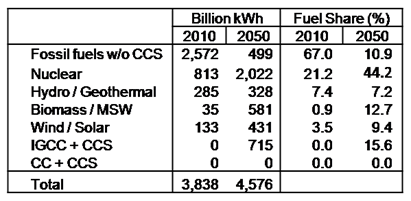According to EPA’s core policy analysis of Senators Kerry and Lieberman’s proposed legislation released yesterday, nuclear energy is projected to generate 44.2% of the US’ electricity in 2050, more than any other source. Total nuclear capacity is projected to more than double from 101 gigawatts in 2010 to 256 gigawatts in 2050 (assuming 90% capacity factor). This means that if all existing operating plants in the US retire at 60 years, the US will need to build another 253 GW or 181 new plants (assuming 1,400 MW each). There are not many quotes for nuclear in the two reports at the link above, but the good numbers below are found in their data tables in the zip folder.
US Electricity Generation Stats IGCC – integrated gasification combined cycle coal plants, CCS – carbon capture and sequestration, MSW – municipal solid waste, CC – combined cycle gas plants
IGCC – integrated gasification combined cycle coal plants, CCS – carbon capture and sequestration, MSW – municipal solid waste, CC – combined cycle gas plants
For comparison, EPA’s analysis last summer of the Waxman/Markey House bill projected the need for 262 GW of nuclear power by 2050 (187 new plants if all existing retire at 60). In that analysis, nuclear is projected to supply 41% of total US electricity, more than any other source (data also found in the zip folder).
From EPA’s APA analysis: “Overall, the estimated impacts of the APA are very similar to those of H.R. 2454 [Waxman/Markey]”.
Not much else to say…

Comments